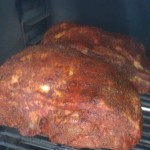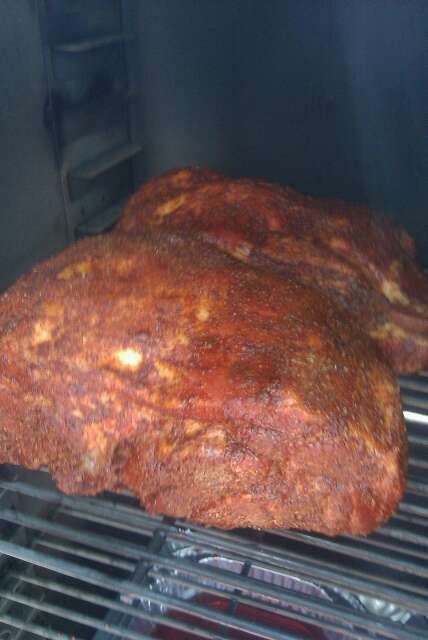Happy Memorial Day. On the weekend where we remember our heroes both living and dying, we wish all the very best. May your smokers be smoking, your grills be grilling, your refrigerators be chilling, and your TVs be a racin’. Please take some time to thank a veteran or at least be thankful of today’s freedoms provided through great sacrifice. Cheers!
We have two pork boston butts smoking today. Tracey will be heading to the market soon to pick up the compliments. We’re having a vinegar based cole slaw, collard greens, and who knows what else she’ll come back with. Other than the pork butts, we’re shooting for easy today. Easy livin’ is our theme.
We’re mixing things up with the pork butt today in two areas: 1) prep and 2) fire.

With prep, we rubbed the pork butt down about an hour before smoking. Normally we apply a dry rub at least 18 hours before cooking. Today we are using a dry rub recipe from Big Bob Gibson’s BBQ Book by Chris Lilly and thought we would switch up our technique too. Validation, right?
The fire technique is going through a good bit of testing too. First we’re using a combination of briquette, wood, and lump charcoal. Secondly, we’re building a secondary fire in the Weber to feed the smoker. Sounds nutty and it might be.
Our primary fire was started with natural lump charcoal. We brought the smoker up to around 425 then added briquettes. The temp peaked at about 500 before I choked it down to 220. I then added two sticks of cherry wood (barked removed) just minutes before the pork butts went in.
With the second fire, I’ve built a base of briquettes for low and slow heat. I plan to add two larger sticks of hickory and burn those down into coal. I’ll use the hot coals from the Weber to refuel the primary fire.
This is quite different from our normal approach but very similar to when I used the Weber exclusively for all my outdoor cooking. The briquettes maintain their temperature better over longer periods of cooking. The lump charcoal is great when you need smoke and heat – at the beginning of the cooking process, not at the end. The wood is ideal for well, hard wood smoke to penetrate the meat. We really need the hardwood for the first half of the cooking not after.
Over the entire 8-10 hours of cooking, I’m attempting to eliminate heat spikes and burn off in the smoker. I’ve observed when adding charcoal to the smoker inevitably coal dust can move through the smoke chamber. There is also a “burn off” effect in fumes and heat. Both of these impacts taste of the bark and meat I believe.
So the overall goal with today’s testing is to a) understand how rub time makes a difference and b) improve quality of taste and cook time.
We’ll be posting through the day. Check back in or follow the tweets from Twitter.
Salud!

